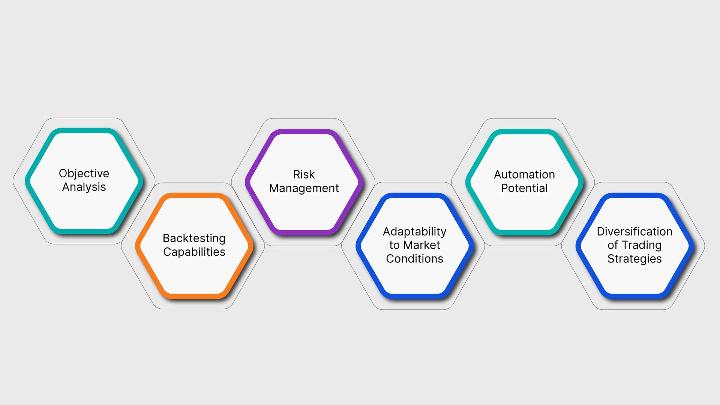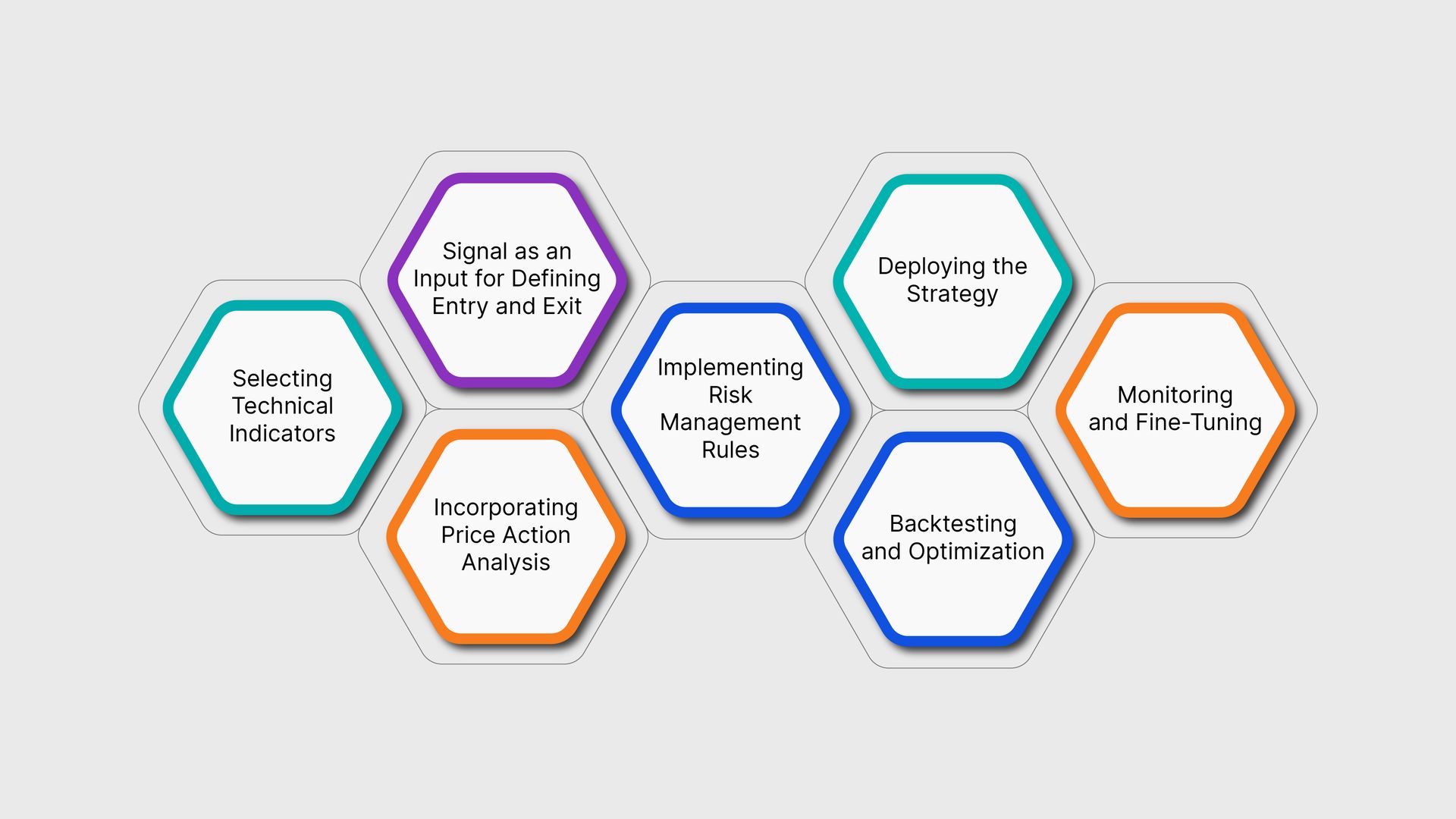The creation of an indicator-based strategy in a strategy builder involves a systematic and methodical approach that integrates technical indicators, price action, and risk management principles to generate trading signals.
Here, we aim to provide a comprehensive guide on how to create an indicator-based strategy in strategy builder. By 2030, the size of the worldwide algorithmic trading market is expected to reach USD 3.56 billion, and traders should use a high-quality algo trading software for most benefits.
Here, we aim to provide a comprehensive guide on how to create an indicator-based strategy in strategy builder. By 2030, the size of the worldwide algorithmic trading market is expected to reach USD 3.56 billion, and traders should use a high-quality algo trading software for most benefits.
Why Create Indicator Based Strategy in Strategy Builder?
Creating an indicator-based strategy in a strategy builder is of immense importance. It offers a lot of benefits to traders. Some of the main benefits of creating an indicator-based strategy in strategy builder are discussed here:

1. Objective Analysis
Indicator-based strategies are also beneficial as they allow for objective analysis. In trading, emotions like fear and greed have a big influence on a person and, thus, hinder one from making rational decisions.
Therefore, it is possible to state that while using an indicator-oriented approach, traders are able to shift to a more analytical angle. It can be seen that indicators offer measurable values and can be easily interpreted in the same way as by another individual, which is essential for defining market conditions without the influence of feelings.
Therefore, it is possible to state that while using an indicator-oriented approach, traders are able to shift to a more analytical angle. It can be seen that indicators offer measurable values and can be easily interpreted in the same way as by another individual, which is essential for defining market conditions without the influence of feelings.
2. Backtesting Capabilities
Backtesting is one of the critical steps in creating a sound trading strategy. It is possible to devise an indicator-based strategy that will allow the trader to check how effective the current approach is or could be in the future.
This involves the actual trading in the market environment using past data on how the strategy would have performed. One advantage of the process is the involvement of backtesting to reveal the possible profitability and risks of the strategy.
This involves the actual trading in the market environment using past data on how the strategy would have performed. One advantage of the process is the involvement of backtesting to reveal the possible profitability and risks of the strategy.
3. Risk Management
Safety always matters in trading, and this is why use of indicators can be used to reduce possible risks. It also means that indicators can show not only entry and exit signals but also stop loss levels and the size of the position.
Hence, by including risk management principles as a part of an indicator-based trading strategy, traders are able to safeguard their capital yet still seek to make the best out of it, and this forms a better approach to trading.
Hence, by including risk management principles as a part of an indicator-based trading strategy, traders are able to safeguard their capital yet still seek to make the best out of it, and this forms a better approach to trading.
4. Adaptability to Market Conditions
Financial markets are never constant; they keep on changing due to several factors, such as economic indicators and sentiments. An indicator-based strategy is one that enables traders to work proficiently in such situations and change the market conditions for the better.
Most of them are intended to react to fluctuations in the market and trends and give the trader prompt signals for changes to be made. Strategy builders are used frequently in custom trading algo development since they allow.
Most of them are intended to react to fluctuations in the market and trends and give the trader prompt signals for changes to be made. Strategy builders are used frequently in custom trading algo development since they allow.
5. Automation Potential
Technological advancement in trading has created new ways of automating trading and indicator-based approaches are ideal for automation. An options strategy builder can give traders the ability to automate the strategies based on certain parameters or rules of the trader’s choice.
Liquidity can also be improved greatly by automation since trades can be done automatically without the need to monitor them all the time.
Liquidity can also be improved greatly by automation since trades can be done automatically without the need to monitor them all the time.
6. Diversification of Trading Strategies
The development of strategies based on indicators helps a trader to adapt various trading styles, which contributes to risk minimization and the development of the trader’s portfolio.
This way traders can diversify a risk and apply several strategies based on different indicators thus providing coverage for the condition of the assets in the market.
This way traders can diversify a risk and apply several strategies based on different indicators thus providing coverage for the condition of the assets in the market.
Steps to Create Indicator-Based Strategy in a Strategy Builder
Implementation of an indication-based strategy in an options strategy builder requires a methodical approach. Following the necessary steps involved in the process carefully is vital. Here are the steps to create an indication-based strategy in a strategy builder:

1. Selecting Technical Indicators
The first process of developing an indicator-based strategy is to determine the right technical indicators suitable for the trading goals as well as the market environment.
In SpeedBot’s Strategy Builder, one can find a list of most prevalently used indicators, such as moving averages, oscillators, technical indicators based on trends, and volatility indicators. Each of the given indicators can be relevant in specific cases and can work well when integrated into the traders’ strategies.
In SpeedBot’s Strategy Builder, one can find a list of most prevalently used indicators, such as moving averages, oscillators, technical indicators based on trends, and volatility indicators. Each of the given indicators can be relevant in specific cases and can work well when integrated into the traders’ strategies.
2. Signal as an Input for Defining Entry and Exit
After the list of technical indicators is chosen, the trader has to specify the conditions under which the indicator will generate buy/sell signals. For instance, the crossover technique may involve a short-term moving average buy signal when it crosses above a long-term moving average and a sell signal when it goes the other way around.
However, it is recommended to apply these signals to historical data to evaluate their efficiency and make necessary adjustments to the strategy parameters.
However, it is recommended to apply these signals to historical data to evaluate their efficiency and make necessary adjustments to the strategy parameters.
3. Incorporating Price Action Analysis
Price action analysis is also helpful to add the technical indicators since it helps in confirming the signals and look for the reversal and continuation patterns.
In addition, SpeedBot’s Strategy Builder enables users to add on top of the price action tools such as support and resistance levels, candlestick patterns, and chart patterns to accompany the indicator-based signals.
In addition, SpeedBot’s Strategy Builder enables users to add on top of the price action tools such as support and resistance levels, candlestick patterns, and chart patterns to accompany the indicator-based signals.
4. Implementing Risk Management Rules
Risk management is very important while trading, and with the help of the Strategy Builder, one can incorporate risk management rules in SpeedBot.
These rules comprise setting stop-loss and take-profit levels, position sizing based on account equity or risk percentage, and implementing trailing stops to protect profits.
These rules comprise setting stop-loss and take-profit levels, position sizing based on account equity or risk percentage, and implementing trailing stops to protect profits.
5. Backtesting and Optimization
Having determined the strategy parameters, the traders ought to run a backtest in order to measure the efficiency of the indicator-based strategy using historical data.
Backtesting of SpeedBot’s Strategy Builder also provides the trader with full information on the profitability, drawdown, win rate, and other important data. Moreover, the trader is able to adjust the parameters of the strategy to achieve the best result in certain market environments.
Backtesting of SpeedBot’s Strategy Builder also provides the trader with full information on the profitability, drawdown, win rate, and other important data. Moreover, the trader is able to adjust the parameters of the strategy to achieve the best result in certain market environments.
6. Deploying the Strategy
After testing the specific approach of applying indicators, which has been carried out and modified to the last detail, the trader can then proceed to put the strategy to work in a live trading environment thanks to SpeedBot’s Options Strategy Builder.
It offers the capability of trading with multiple markets, such as equities, foreign exchange, commodities, and cryptocurrencies, and this enables traders to work effectively on the platform.
It offers the capability of trading with multiple markets, such as equities, foreign exchange, commodities, and cryptocurrencies, and this enables traders to work effectively on the platform.
7. Monitoring and Fine-Tuning
Constant supervision and adjustments of the strategy that utilizes the selected indicator are critical due to fluctuations in market conditions and increasing competitiveness.
Regarding the evaluation of the strategy, it is essential to mention the performance metrics of SpeedBot’s Strategy Builder, which enables traders to evaluate the real-time performance of the strategy and make the required modifications to the parameters of the strategy.
Regarding the evaluation of the strategy, it is essential to mention the performance metrics of SpeedBot’s Strategy Builder, which enables traders to evaluate the real-time performance of the strategy and make the required modifications to the parameters of the strategy.
Want to boost your trading with an options strategy builder?
Conclusion
Creating an indicator-based strategy in an options strategy builder is a meticulous process that requires a deep understanding of technical analysis, market dynamics, and risk management principles. Traders can develop effective indicator-based strategies that align with their trading objectives by following the key steps discussed here and also achieve better results through custom trading algo development.